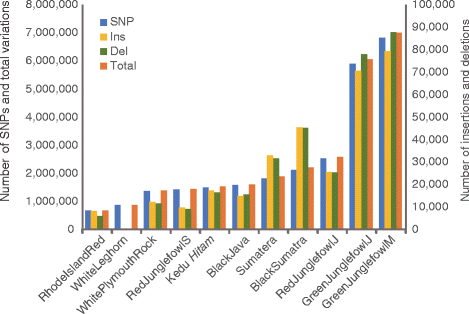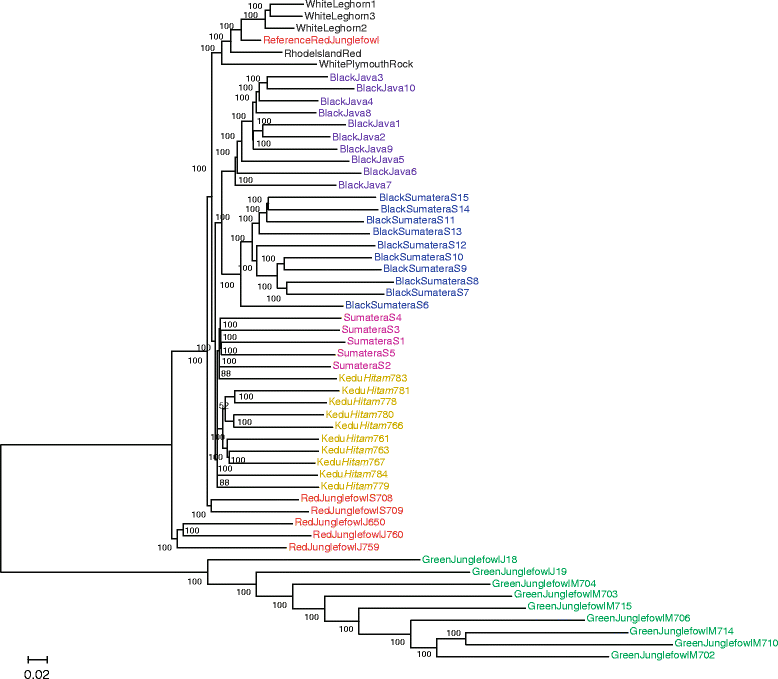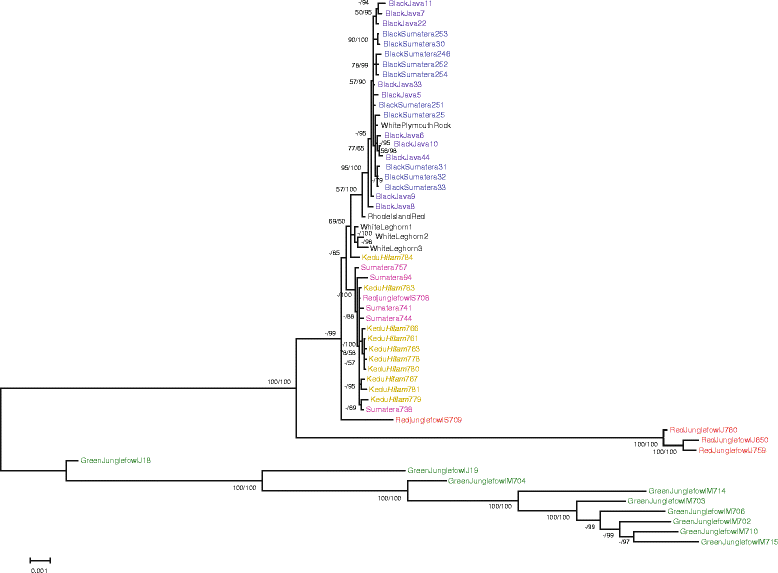Genetic features of red and green junglefowls and relationship with Indonesian native chickens Sumatera and Kedu Hitam
- PMID: 27142387
- PMCID: PMC4855759
- DOI: 10.1186/s12864-016-2652-z
Genetic features of red and green junglefowls and relationship with Indonesian native chickens Sumatera and Kedu Hitam
Abstract
Background: More than 2,500 breeds of chicken are reared throughout the world as a source of eggs or meat and as pets. The primary ancestor of the present domestic chicken is widely believed to be the red junglefowl, although genetic contributions from other junglefowls cannot be excluded entirely. The reference genome for chicken was obtained from a red junglefowl, the genetic purity of which has been debated. There is, at present, insufficient data to resolve these interesting issues.
Results: In this study, we performed whole-genome sequencing to compare various species and breeds of chicken, including wild red and green junglefowl, as well as the Indonesian native chickens Sumatera and Kedu Hitam and their respective descendants, the American Black Sumatra and Black Java. The data indicate that wild junglefowls have retained their genetic identity, but the Indonesian and American breeds have not. The Black Sumatra and Black Java are now closely related to each other, suggesting loss of genetic identity after export to the United States. In addition, the results indicate that the red junglefowl used as reference genome is more closely related to domestic chickens and apparently different from other wild red junglefowls.
Conclusions: This study illuminates the genetic and phylogenetic relationships among these species. It provides a framework for genetic studies in wild junglefowls and native and domestic chicken breeds.
Keywords: Green junglefowl; Indonesian native chicken; Mitochondrial DNA; Phylogeny; Red junglefowl; SNP; Whole-genome sequencing.
Figures




Similar articles
-
High genetic divergence in miniature breeds of Japanese native chickens compared to Red Junglefowl, as revealed by microsatellite analysis.Anim Genet. 2008 Feb;39(1):71-8. doi: 10.1111/j.1365-2052.2007.01690.x. Anim Genet. 2008. PMID: 18254737
-
The origin and genetic variation of domestic chickens with special reference to junglefowls Gallus g. gallus and G. varius.PLoS One. 2010 May 19;5(5):e10639. doi: 10.1371/journal.pone.0010639. PLoS One. 2010. PMID: 20502703 Free PMC article.
-
[Studies of the origin of Chinese domestic fowls].Yi Chuan Xue Bao. 2001 May;28(5):411-7. Yi Chuan Xue Bao. 2001. PMID: 11441653 Chinese.
-
Domestic chicken diversity: Origin, distribution, and adaptation.Anim Genet. 2021 Aug;52(4):385-394. doi: 10.1111/age.13091. Epub 2021 May 31. Anim Genet. 2021. PMID: 34060099 Review.
-
The chicken genome.Genome Dyn. 2006;2:123-137. doi: 10.1159/000095100. Genome Dyn. 2006. PMID: 18753775 Review.
Cited by
-
Identification and characterisation of endogenous Avian Leukosis Virus subgroup E (ALVE) insertions in chicken whole genome sequencing data.Mob DNA. 2020 Jun 30;11:22. doi: 10.1186/s13100-020-00216-w. eCollection 2020. Mob DNA. 2020. PMID: 32617122 Free PMC article.
-
Multiple ancestral haplotypes harboring regulatory mutations cumulatively contribute to a QTL affecting chicken growth traits.Commun Biol. 2020 Aug 28;3(1):472. doi: 10.1038/s42003-020-01199-3. Commun Biol. 2020. PMID: 32859973 Free PMC article.
-
Genome-wide scan for selection signatures and genes related to heat tolerance in domestic chickens in the tropical and temperate regions in Asia.Poult Sci. 2022 Jul;101(7):101821. doi: 10.1016/j.psj.2022.101821. Epub 2022 Mar 7. Poult Sci. 2022. PMID: 35537342 Free PMC article.
-
Genetic traceability, conservation effectiveness, and selection signatures analysis based on ancestral information: a case study of Beijing-You chicken.BMC Genomics. 2025 Apr 24;26(1):402. doi: 10.1186/s12864-025-11563-4. BMC Genomics. 2025. PMID: 40275158 Free PMC article.
-
The wild species genome ancestry of domestic chickens.BMC Biol. 2020 Feb 12;18(1):13. doi: 10.1186/s12915-020-0738-1. BMC Biol. 2020. PMID: 32050971 Free PMC article.
References
-
- The Domestic Animal Diversity Information System [http://dad.fao.org]
Publication types
MeSH terms
LinkOut - more resources
Full Text Sources
Other Literature Sources

